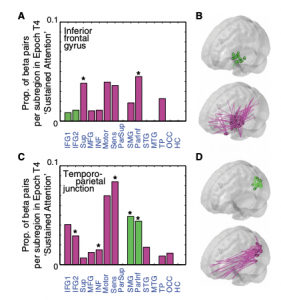This post is also available in Dutch.
The eyes are wonderful instruments to see our surroundings. However, there is another important eye allowing us to see details of the real world: the eye of attention.
Much alike ‘real eyes,’ (visual) attention allows us to scan the environment both when we are watching a Youtube video and when we are strolling down the sidewalk, window shopping for our favorite clothes. Thanks to recent advances in neuroscience, we know that selective attention depends on the internal communication of distant brain areas.

Figure 1. Sometimes we are not aware of important details around us. Image by NPR (license).
But before continuing let’s take a test to check if the eye of your brain is working properly. Watch the following video and follow the instructions in it.
Did you succeed in the task?
As seen in the video, while people were exchanging balls a black gorilla entered the scene and pounded its chest before leaving. Did you see it? Some observers don’t even notice the gorilla! One important question here is: why do we miss this? Why does the brain’s eye act like a flashlight in the darkness?
Attention really depends on whether we are engaged or not with another task… and apparently, following a ball gives you an immediate reward, like a high score in a game!
The opposite of being focused could happen in real life when, for example, while talking to a friend we might unconsciously be distracted by something happening in our periphery, a bit further away but very interesting (e.g., a tasty cake or maybe a sexy person walking by).
All this is unconscious and it happens because we are internally wired to track rewards. Let’s read further about the reasons.
The unconscious nature of reward and attention
As part of a group of scientists, I tried to understand what mechanisms act in our brains to explain the phenomenon of selective attention. According to our recent study we can even see faint images, if they have a large value for us. Most interestingly the experiment makes clear that communication between two large brain areas; the parietal and frontal areas, allows us to sync our inner goals with the visual stimuli and that this mechanism is unconscious.
In the experiment what people saw was so faint and so quick that not all details were perceived consciously. Nonetheless this was enough to provoke a motor response (a mouse click). At the same time a set of electrodes on the participants’ brains recorded the synchronisation of the parietal-frontal communication network (see figure 2)!

Figure 2. Frontal areas (upper panel) and parietal areas (lower panel) communicate with each other if we are focused on one visual object, thereby excluding distracting stimuli (such as a gorilla). Green and magenta are respectively, the colors of internal and external communication within each brain area.
Image courtesy of Cristiano Micheli (license)
Importantly, when we are focused on a task some dynamic communication channels open up to transfer information between far-away cortical areas. The value of the things we see is relevant because important objects are recognised by the ‘brain’s eye’ and all others are unconsciously excluded, no matter how big they are (like a huge gorilla).
So, in short, pay attention to the gorilla standing near to you next time!
Written by Cristiano Micheli, edited by Annelies van Nuland and Monica Wagner, translated by Rowena Emaus
